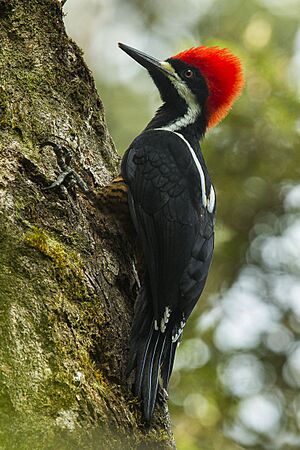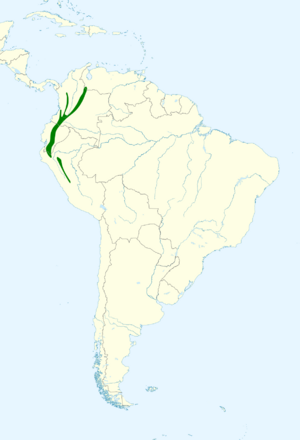Powerful woodpecker facts for kids
Quick facts for kids Powerful woodpecker |
|
|---|---|
 |
|
| Conservation status | |
| Scientific classification | |
| Genus: |
Campephilus
|
| Species: |
pollens
|
 |
|
The powerful woodpecker (Campephilus pollens) is a type of woodpecker, a bird known for pecking holes in trees. It belongs to the Picidae family. You can find this bird in several South American countries. These include Colombia, Ecuador, Peru, and Venezuela.
Contents
About This Woodpecker
The powerful woodpecker is a medium-sized bird, growing to about 32 centimeters (12.6 inches) long. Males and females look very similar, but you can tell them apart by their heads.
What They Look Like
- Males: Have a bright red head, from their forehead all the way to their crest (the feathers on top of their head).
- Females: Have a black head in the same area where the male is red.
Both male and female powerful woodpeckers have a black and white face. A wide white stripe runs from their eyes down the side of their neck. Their back, shoulders, and upper back are black with thin white stripes. The lower part of their back and their rump are white.
Their wings are mostly black, with white tips on the main flight feathers. The underside of their wings is blackish with white stripes. Their tail is black. The chest is black, and the rest of their belly is a cinnamon-buff color with black stripes or V-shapes.
Their beak is long and black, shaped like a chisel for pecking wood. Their eyes are white or pinkish-white, and their legs are dark gray.
Young Woodpeckers
Young powerful woodpeckers look a lot like the adults. However, their colors are not as bright, and they are a bit browner. They also have more stripes on their upper body and wider stripes on their belly.
Different Types
There are two main types, or subspecies, of the powerful woodpecker. One is called C. p. pollens, and the other is P. c. peruvianus. The peruvianus type often has a cinnamon-buff lower back and rump, sometimes with black stripes. It can also have cinnamon-buff stripes on its black tail feathers.
Where They Live
The powerful woodpecker lives in the Andes Mountains. The C. p. pollens subspecies is found from north-central Colombia and southwestern Venezuela down through Ecuador. The P. c. peruvianus subspecies lives on the eastern side of the Peruvian Andes.
Their Home Environment
These woodpeckers mostly live inside and on the edges of old, grown-up forests. They prefer humid and wet forests, including cloudforests, which are forests often covered in clouds. They can also be found in younger forests that are regrowing.
They live at high elevations, usually between 900 to 3,750 meters (about 2,950 to 12,300 feet) above sea level. Most often, you'll find them between 1,700 to 2,600 meters (about 5,570 to 8,530 feet) high.
How They Behave
Powerful woodpeckers stay in the same area all year round. They do not migrate.
What They Eat
These woodpeckers look for food at all levels inside the forest. They often search for food in pairs. We don't know many specific details about what they eat, but like most woodpeckers, they likely eat insects found in trees.
Reproduction and Life Cycle
The powerful woodpecker's breeding season is thought to be from April to August. They build their nests inside dead tree trunks. Scientists have found nests with either two eggs or a single baby bird. In one case, the eggs hatched after at least 16 days. The baby bird then left the nest about 34 to 37 days after hatching. It seems that both parent birds help to warm the eggs until they hatch.
Sounds They Make
The powerful woodpecker makes several different sounds:
- Their most common call is a nasal "kyaaah" or "peeyáw," which they often repeat.
- When flying, they make a fast "kikikikikawh" sound.
- When they are excited, they make a "descending kikikiki-keh-keh-kah-kah" sound.
- They also drum on trees with a short, double tap.
Conservation Status
The IUCN (International Union for Conservation of Nature) has evaluated the powerful woodpecker. They have listed it as a species of "Least Concern." This means that while its population is believed to be decreasing, it is not currently in immediate danger of extinction.
The powerful woodpecker lives across a large area. However, we don't know exactly how many of these birds there are. No major threats to their survival have been identified right now. They are considered rare in some parts of their range but are found in a few protected areas.


